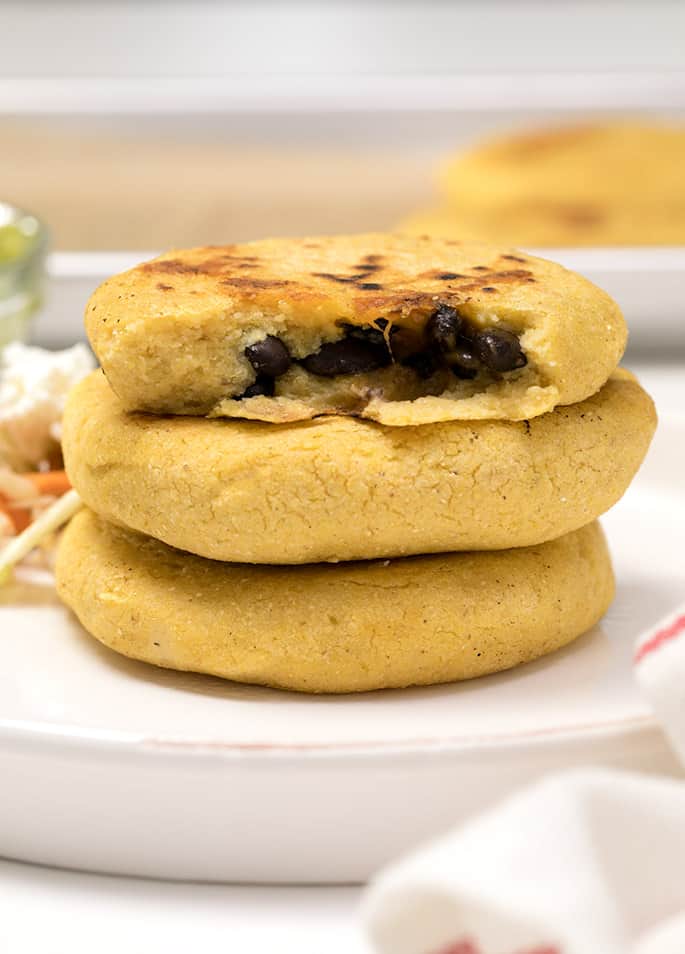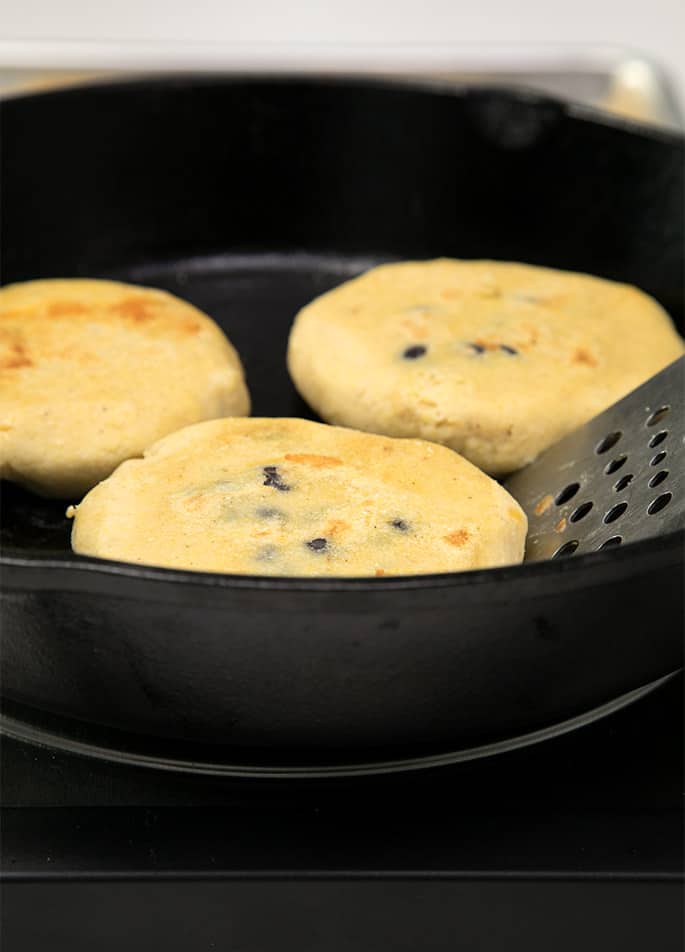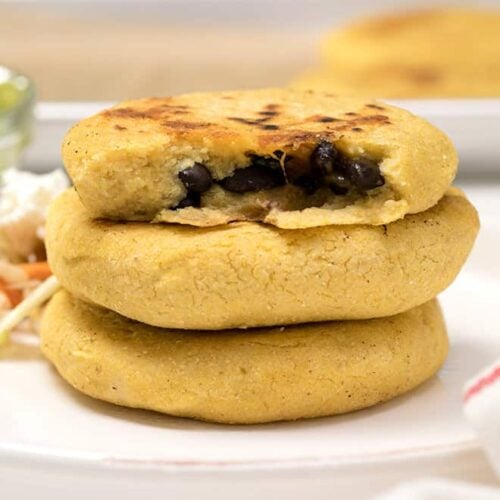

This pupusas recipe for stuffed corn cakes is for when the cupboards are nearly bare, you need a hearty handheld meal—and you need it fast!

WANT TO SAVE THIS RECIPE?
What are pupusas?
This pupusas recipe, for El Salvadoran corn cakes made with masa and stuffed with yummy stuff like garlic, onions, cheese, pork, or beans, is absolutely one of my go-to recipes. They're naturally gluten free, and they could not be simpler.
I have a special place in my heart for Latin American cuisine, since so much of it is naturally gluten-free. They're not wheat junkies like we Americans are.
Although pupusas originated in El Salvador, they're also popular in Honduras. Pupusas are also really common in Northern California, and when my family and I took a trip there a few years ago, the most common gluten free friendly restaurants had pupusas on the menu.
Are all pupusas gluten free?
Pupusas are naturally gluten free. Like anything else, though, they can be “glutened” if wheat flour is added to it, any of the filling ingredients are gluten-containing, or the masa harina used is contaminated with gluten-containing ingredients.
They're made primarily with masa harina corn flour, which is a precooked cornmeal that's dried, treated with limewater (also known as slaked lime or calcium hydroxide), then dried again. If you start researching slaked lime too much, you might not want to eat anything with masa harina. It has mostly industrial applications. But it gives masa harina its amazing aroma and flavor, and, well, it's gluten free. ?
The moment you open a bag of masa harina corn flour, you'll be reminded of fresh corn tortillas, which are made with the corn flour and water. Pupusas are thicker and more savory as they're filled before being cooked. Corn tortillas are cooked plain. For another meal option using masa harina, try my recipe for Colombian empanadas.
If you've only ever had packaged corn tortillas, you really should try making them fresh. Two of my three children will only bother to eat corn tortillas when I make them fresh, as that's ruined them for eating the packaged kind.
Working with masa harina to make pupusas
I typically buy Bob's Red Mill brand masa harina corn flour, as it's available through Amazon.com for a good price. If you're gluten free, just be sure you buy the variety that's labeled “gluten free.”
Maseca brand is also labeled gluten free, but in the grocery store it's often stored on a shelf right next to some sort of wheat flour, so I prefer to buy it online.
You'll be surprised how easy it is to work with a simple dough made of masa harina and water. The masa absorbs the water fully after a few minutes, so it's useful to cover the dough and let it rest briefly before working with it, or you might over hydrate it.
You'll know that the masa has too much water added to it if, after a few minutes, the dough is too soft to hold its shape properly. It's easy to add more masa to get to the proper consistency, though. It's easier still to add more water by the teaspoonful, though, so add less water at first.
The texture of properly made pupusa dough is like Play-Doh. You're better off working with it slightly dry (but never crumbly), and then moistening your fingers to seal up any cracked edges after shaping.

How to make pupusas at home
In this pupusas recipe, I use only one piece of dough, then flatten it into a pancake, create a well in the center, fill it, and then shape the masa around the filling. You can make pupusas with two pancakes of masa dough instead of just one. But that method yields a more doughy result, since masa harina alone tends to be bland.
Pupusas can be filled with cheese alone. I like them with beans, cheese, and some spices. They're awesome with pulled pork, too, especially if it's been cooked with plenty of Latin American spices. You can even add some warm spices like ground cumin, smoked paprika and chili powder to the dough itself for more flavor. It doesn't change the ingredient proportions.
Keep in mind that this is like any other new cooking technique: the first few tend to turn out much less beautiful. But you'll hit your stride soon before the dough runs out. The next time you make them, you hit your stride a little sooner.
Pupusas: Ingredients and can you make substitutions?
Since pupusas are so simple, there aren't many ingredients to discuss but here goes:
Can you make pupusas without corn?
If you can't have corn, I'm afraid you really can't have pupusas at least not traditional ones. Although there are recipes on the web for corn-free cornbread, many of which use combinations of millet and almond flour, I've tried many of them and never been satisfied.
Masa harina, as we discussed above, is also quite the unique corn flour as it's treated with slaked lime. Short of curing your own corn substitute, I don't think there's a way to recreate that experience.
Dairy free pupusas
As long as you use a dairy-free cheese in your filling, these pupusas are naturally dairy-free!
What about the beans, meat and other fillings?
Since you can fill pupusas with anything savory, you can make this recipe without beans, without meat or without both quite easily. Get creative!
Pupusas Recipe | From El Salvador
Ingredients
- 2 cups (264 g) gluten free masa harina corn flour
- ½ teaspoon kosher salt
- 1 ½ cups (12 fluid ounces) lukewarm water
- 1 can (15 ounces) black beans drained and rinsed
- Ground cumin chili powder, kosher salt, and freshly ground black pepper to taste
- 2 cups melting cheese like Monterey jack, grated
Instructions
- Line a plate or rimmed baking sheet with parchment paper and set it aside.
Make the dough.
- In a large bowl, place the masa harina, and salt, and mix to combine.
- Create a well in the center, and pour in about 10 fluid ounces of the water. Mix to combine.
- The dough should not be sticky, and not dry, but should be a bit tacky to the touch. Add more water by the tablespoonful, mixing to combine, until there are no crumbly bits.
- The dough is easier to work with a little too wet than a little too dry. Cover the bowl and set it aside for 5 minutes to allow the masa to absorb the liquid.
Make the filling.
- While the dough is resting, in a separate, medium-sized bowl, place the beans.
- Add the desired spices to taste, and mix to combine.
- Place the cheese in a small bowl beside the beans.
- Place a small bowl with warm water beside the cheese.
- Check the dough. If it appears too dry, add a tablespoon of water, wet your hands in the water bowl, and work the water in to the dough.
Shape the rounds.
- Once the dough is ready, divide it into 6 even parts.
- Take each piece of dough and roll it into a ball with wet hands.
- In a rhythmic motion, pat the dough between wet palms until it flattens. If it splits along the edges, just press it back together.
- Pupusas are not meant to rise when cooking, so a tight seal around the edges is not necessary.
Fill the pupusas.
- Press the center of the flattened dough gently into the palm of your hand to create a well for the filling.
- Add a spoonful of the black beans to the well, and top with a couple tablespoons of grated cheese. The dough will be nearly covered with filling.
- With the hand that is cradling the pupusa, begin to close the edges of the dough toward the center, rotating the ball in your hand as you work. Your free hand should help to thin the dough a bit to cover the filling.
- Once the filling is covered with the dough, pat the dough flat again between moistened palms.
- Place on the lined plate or baking sheet, and repeat with the remaining pieces of dough and filling.
Cook the pupusas.
- Heat a 12-inch cast iron pan over medium-high heat.
- Place as many pupusas as will fit without crowding one another in the pan, and allow to cook on one side for about 3 minutes, or until the underside is no longer shiny and beginning to brown.
- Flip the pupusas with a metal spatula, and allow to cook on the other side for another 3 to 4 minutes. Serve warm.
Notes
WANT TO SAVE THIS RECIPE?

Thanks for stopping by!
Hi, I’m Nicole. I create gluten free recipes that really work and taste as good as you remember. No more making separate meals when someone is GF, or buying packaged foods that aren’t good enough to justify the price. At Gluten Free on a Shoestring, “good, for gluten free” just isn’t good enough! Come visit my bio!




Leese says
With using masa hurina, do they taste like tamales at all? I love tamales but they are so labor intensive.
Nicole Hunn says
I would say that pupusas have a similar taste to tamales with less work, Leese. But the cooking method is completely different and you won’t have any of the flavor imparted from the filling being cooked in a corn husk
Beth says
Have the masa on hand, but I’m going breakfast style with scrambled eggs, crumbled bacon & pepper jack shreds, then serve with avocado slices & salsa .